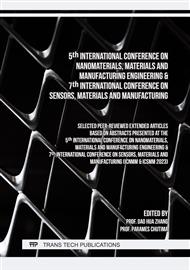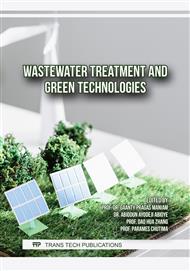[1]
L. Järup, "Hazards of heavy metal contamination," Br Med Bull, vol. 68, pp.167-182, 2003.
DOI: 10.1093/bmb/ldg032
Google Scholar
[2]
S. C. J. Querijero, A. P. L. Melgar, M. C. A. M. Suba, M. M. G. Lagman, K. R. Bucud, and J. C. Millare, "Fabrication and Characterization of Cellulose Acetate/Organo-Montmorillonite Composite Membrane for Ion Adsorption," Key Eng. Mater., vol. 907, p.179–185, Jan. 2022.
DOI: 10.4028/www.scientific.net/KEM.907.179
Google Scholar
[3]
R. R. Aquino, M. S. Tolentino, J. C. Millare, C. D. Balboa, C. J. B. Castro, and B. A. Basilia, "Fabrication and Characterization of Electrospun Polysulfone (PSf) / Halloysite (HAL) Nanocomposite Membrane," Mater. Sci. Forum, vol. 934, p.55–60, Oct. 2018.
DOI: 10.4028/www.scientific.net/MSF.934.55
Google Scholar
[4]
M. Sivakumar, R. Malaisamy, C. J. Sajitha, D. Mohan, V. Mohan, and R. Rangarajan, "Preparation and performance of cel-lulose acetate-polyurethane blend membranes and their applications - II," J Memb Sci, vol. 169, no. 2, pp.215-228, 2000.
DOI: 10.1016/S0376-7388(99)00339-7
Google Scholar
[5]
M. B. M. Y. Ang et al., "Modifying Cellulose Acetate Mixed-Matrix Membranes for Improved Oil–Water Separation: Comparison between Sodium and Organo-Montmorillonite as Particle Additives," Membranes, vol. 11, no. 2, p.80, Jan. 2021.
DOI: 10.3390/membranes11020080
Google Scholar
[6]
V. L. J. L. Vasquez, J. E. Dela Rosa, I. F. C. Lim, and J. C. Millare, "Self-Healing of Epoxy-Loaded Halloysite Nanotubes/Polysulfone Nanocomposite Membrane," Mater. Sci. Forum, vol. 1053, p.91–97, Feb. 2022.
DOI: 10.4028/p-4sw45k
Google Scholar
[7]
M. Zhu, J. Lan, C. Tan, G. Sui, and X. Yang, "Degradable cellulose acetate/ poly-L-lacticacid / halloysite nanotube composite nanofiber membranes with outstanding performance for gel," J Mater Chem A, no. 31, 2016.
DOI: 10.1039/C6TA05207J
Google Scholar
[8]
A. A. Valeros, A. Panganiban, and J. C. Millare, "Fabrication and Characterization of Nanozeolite-Modified High Impact Polystyrene (HIPS) Membranes for Nanofiltration," Key Eng. Mater., vol. 931, p.93–98, Sep. 2022.
DOI: 10.4028/p-t8746y
Google Scholar
[9]
M. Gouamid, M. R. Ouahrani, and M. B. Bensaci, "Adsorption equilibrium, kinetics and thermodynamics of methylene blue from aqueous solutions using Date palm Leaves," Energy Procedia, vol. 36, pp.898-907, 2013.
DOI: 10.1016/j.egypro.2013.07.103
Google Scholar
[10]
C. J. L. Tagalog, A. R. Caparanga, and J. C. Millare, "Dispersion and diffusivity of halloysite and bentonite nanoclays in aqueous Pb (II): Effect of particle concentration, temperature, and pH," IOP Conf. Ser. Earth Environ. Sci., vol. 344, no. 1, p.012040, Oct. 2019.
DOI: 10.1088/1755-1315/344/1/012040
Google Scholar
[11]
B. Shoba, J. Jeyanthi, and S. Vairam, Synthesis, characterization of cellulose acetate membrane and application for the treatment of oily wastewater, vol. 41, no. 12. Taylor & Francis, 2020.
DOI: 10.1080/09593330.2018.1543353
Google Scholar
[12]
V. Khunova, J. Kristóf, I. Kelnar, and J. Dybal, "The effect of halloysite modification combined with in situ matrix modifica-tions on the structure and properties of polypropylene/halloysite nanocomposites," Express Polym Lett, vol. 7, no. 5, pp.471-479, 2013.
DOI: 10.3144/expresspolymlett.2013.43
Google Scholar
[13]
L. Li, F. Wang, Y. Lv, J. Liu, D. Zhang, and Z. Shao, "Halloysite nanotubes and Fe3O4 nanoparticles enhanced adsorption removal of heavy metal using electrospun membranes," Appl Clay Sci, vol. 161, no. March, pp.225-234, 2018.
DOI: 10.1016/j.clay.2018.04.002
Google Scholar
[14]
N. Li, "Synthesis and characterization of a high flux nanocellulose–cellulose acetate nanocomposite membrane," Membr. Basel, vol. 9, no. 6, 2019.
DOI: 10.3390/membranes9060070
Google Scholar



